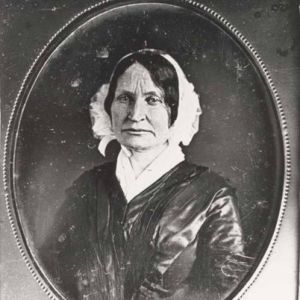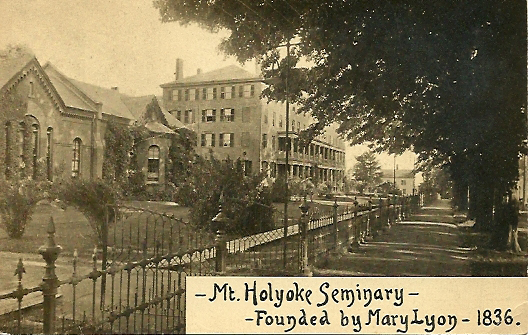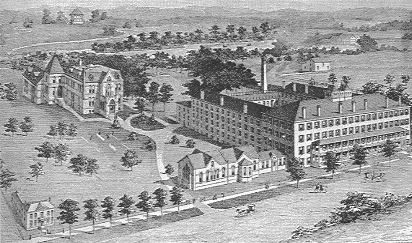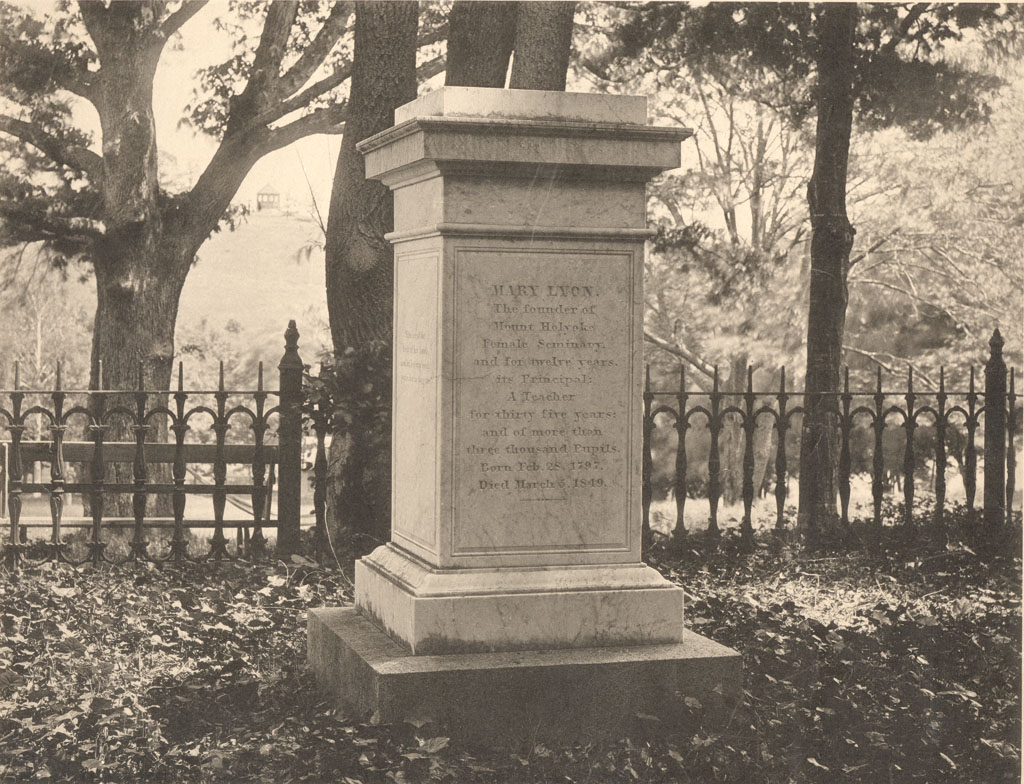Go where no one else will go, do what no one else will do.
There is nothing in the universe that I fear but that I shall not know all my duty, or shall fail to do it. Mary Lyon
Mary Mason Lyon was born on February 28, 1797 in Buckland, Massachusetts, the sixth child of Aaron and 
Jemima Lyon. Mary’s strong Christian faith was shaped by her New England ancestors that included ministers, deacons, and selectmen. They were solid, conservative folks, mostly farmers and craftsmen.
An intense interest in foreign missions began in her childhood years that would remain all her life. Mary longed for the day when all of the kingdoms of the world would belong to the Redeemer. Mary was really a missionary at heart as well as a teacher and would later found the first missionary society in Buckland.
Sadly, Mary’s father died when she was only five years old. Mary was able to go to school but had to quit when she was 17 in order to help support the family. Mary took a teaching position in a country school in Massachusetts. It was not unusual in those days for women to begin to teach without a college education. Mary was very bright and well able to teach young children.
In 1817 at age 20, Mary began to fulfill her dream and go to school to further her education. She paid for her education by teaching and by selling blankets that she had woven from homespun material. She attended Saunderson Academy in Ashfield and Amherst Academy in Amherst, Massachusetts. Then in 1821 at the age of 24 Mary attended the school and studied under the man that would influence her for the rest of her life, Reverend Joseph Emerson.
In 1818 Reverend Joseph Emerson founded Byfield Female Seminary. Joseph Emerson was an unusually energetic Puritan who followed the teachings of Jonathan Edwards. Because of poor health he changed from preaching to teaching and started Byfield with the help of his wife and daughter.
Joseph Emerson’s religious convictions were at the center of his teaching. He had a Biblical worldview that emphasized that every act of the mind could and should contribute to the glory of God. Mary Lyon would imbibe this faith completely and emphasize it in her own teaching along with a salvation message.
In 1824 Mary went on to start her own girls’ school back in her hometown of Buckland. Mary believed that education should be affordable for middle-class girls and kept the tuition low. The number of students grew from 25 to nearly 100. The girls helped to pay their own intuition by working while attending school. This was a “winter” school so the girls could also work and save up in the summers.
In the summers, Mary joined her friend Zilpah Grant in New Hampshire. These women set a precedent by granting diplomas to girls who graduated. Zilpah insisted that the curriculum should consist of serious subjects such as math, science, philosophy, and theology instead of the frivolous curriculum that was in many girls’ schools. The trustees of the schools were against teaching women serious subjects and also incensed at the strong Calvinistic emphasis of the women. They tried to force shallow music and dancing on the school so Zilpah and Mary quit and moved on.
The women each went their own way for a few years and then in 1830 Mary again joined Zilpah at Ipswich Female Academy. Here again the women struggled to maintain an academy that taught serious subjects. Their wish was to prepare women for higher education.
Several years later Mary began her famous labors to found an institution of higher learning for women. She traveled as far away as Detroit to examine schools. She met and learned much from Emma Willard, founder of a school in Troy, New York, also still in existence today. Emma too desired serious education for women. Mary desired to follow Emma’s model but at a more advanced level.
Mary set out to raise the money for a female seminary. She set out mostly on foot going door-to-door in small and large communities to raise the $30,000 she needed to open her school. She worked tirelessly for three years. She appealed for donations in the name of religion and based on the principle that education of the daughters of the Church called as rightfully for the free gifts of the Church as does that of her sons.
 Man people agreed with her and in spite of so many others who discouraged or disdained her efforts Mary raised the money. Male town officials in Hadley, Massachusetts donated $8,000 and so the site for Mount Holyoke Female Seminary was located there.
Man people agreed with her and in spite of so many others who discouraged or disdained her efforts Mary raised the money. Male town officials in Hadley, Massachusetts donated $8,000 and so the site for Mount Holyoke Female Seminary was located there.
Mary’s main purpose for the school was religious but she also sought to give the women a practical education. She also intended to make sure that the school was a financial success. Therefore, the students did all of the domestic chores of the school themselves. Many students also obtained domestic work while attending. This enabled Mary to keep the tuition low making it possible for middle-class women to attend. Her school was a financial success even during the depression of 1837.
And, Mary had the encouragement of men like Rev. Emerson who said:
…may we not indulge the enrapturing hope, that the period is not remote, when female institutions, very greatly superior to the present, will not only exist, but be considered as important, as are now our colleges for the education of our sons. The distinguished honor is probably reserved for our rising republic, to exhibit to the world examples of such female seminaries as the world has never witnessed. But where such an institution shall be erected, by whom it shall be founded, and by whom instructed, it is yet for the hand of Providence to develop. Possibly some of our children may enjoy its advantages.
Rev. Emerson wrote these words in 1833. Three years later Mary Lyon was granted the first charter to a school of higher education for women – the Mount Holyoke Female Seminary. One year after that in September 1837 the school would officially open after the completion of the building. 80 eager young women would attend that first year. The following year 400 applicants were turned away due to lack of space. The school has grown and is still in existence today. How thankful we should be that brave men and women like Joseph Emerson and Mary Lyon fought against public sentiment and pushed for equal education for women.
For nearly twelve years Mary directed the seminary. Prayer and dedication led to many women strengthening  their faith in Christ. Many who did not have a commitment to Christ became children of God while studying at Mount Holyoke. In the first twelve years there were sixteen hundred pupils and more than four hundred and sixty conversions.
their faith in Christ. Many who did not have a commitment to Christ became children of God while studying at Mount Holyoke. In the first twelve years there were sixteen hundred pupils and more than four hundred and sixty conversions.
Miss Isabel Hart wrote about Mary’s effective and generous direction of the school and especially the prime importance of salvation:
Thoroughness of instruction, firmness with gentleness of discipline, lovingness of spirit, beauty of life, bore their appropriate fruit in the type of womanhood molded by her formative hands. But peculiarly what characterized her work was her insatiate longing for that outpouring of the Holy Spirit upon her pupils which would lead to that regenerating work in their own hearts which she felt was the only true basis of Christian character. Without this, at any season and in any place, she felt her work was incomplete.
Mary’s missionary fervor was genuine. She believed that the income from Mount Holyoke belonged to the Lord. She only accepted a modest salary. She gave much of that meagre income to the poor and left her personal property to the American Board of Foreign Missions when she died. The school itself contributed nearly seven thousand dollars to foreign missions in the last seven years that Mary was there.
Her fervor was caught by her students. Many became missionaries. Over the twelve years Mary directed the school, hundreds of women became missionaries, teachers or wives of missionaries. Twelve students went on to take the Gospel to the Indians in the western United States. Scores of pastor’s wives were trained at Mount Holyoke.
Mary suffered from overwork and bad headaches. She died at age 52 on March 5, 1849. She was buried on the 
Mount Holyoke Seminary grounds. A monument was erected that includes the following memorial on one of the four sides:
Servant of God, well done;
Rest from thy loved employ;
The battle fought, the victory won,
Enter thy Master’s joy.
Nineteenth century students praised Mary for many years. They caught her vision still held after so many years after Mary caught it from Joseph Emerson – that all would be to the glory of God. That Christ’s Kingdom would reign in the hearts of men and women.
I wonder how many students at Mount Holyoke think of Mary’s true goal for them as they look on her monument? I fear that many women’s colleges today have strayed from Mary’s vision. I pray that today’s female college students would turn to the Lord and His righteousness again.

